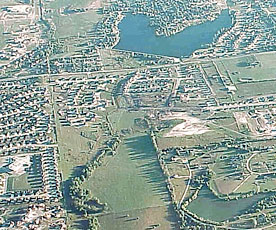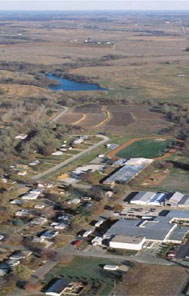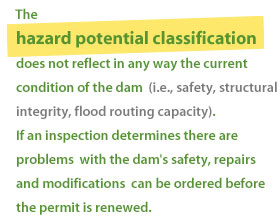About EAPs
What is a High-Hazard Potential Dam?
Each state has definitions and methods to determine the Hazard Potential of a dam. The Hazard Potential is defined as a situation which creates the potential for consequences such as loss of life, property damage, or other adverse impacts.
 Neighborhood association dams in suburban communities can be a significant risk to downstream residents and their homes, workers and their businesses, and even those who may be merely passing through the area.
Neighborhood association dams in suburban communities can be a significant risk to downstream residents and their homes, workers and their businesses, and even those who may be merely passing through the area.
Extensive development downstream from dams in rural areas will increase the risk to lives and property in the event of a dam failure.
These adverse impacts may occur in a defined area downstream of a dam because of flood-waters released through spillways and outlet works of the dam or because of waters released by partial or complete failure of the dam. Adverse impacts also may occur upstream of the dam from effects of backwater flooding or landslides around the reservoir perimeter.
In Missouri, dams are regulated by the state if they are more than 35 feet high and meet certain other criteria. The Missouri Department of Natural Resources (DNR) Water Resources Center (WRC) engineering staff assigns regulated dams to one of three hazard classifications based on what lies within the "downstream environmental zone."
Class I and Class II dams are in the HHP category. A Class I dam's downstream zone contains 10 or more permanent dwellings or any public building. A Class II zone contains one to nine permanent dwellings or one or more industrial buildings, or one or more campgrounds with permanent water, sewer and electrical services.
HHP dams are inspected every two years (Class I) or three years (Class II). A safety inspection is not the same as an EAP. This fact may cause confusion among some dam owners/operators. Every state-regulated dam must have an EAP. Fortunately, through an intensive DNR program to create inundation maps for HHP dams and then work with dam owners to complete EAPs, more than 330 HHP dams now have EAPs as of 2014 and the remaining HHP dams should achieve EAPs during 2015.
Class 3 is Low-Hazard Potential dams. The zone contains 'everything else' not defined as the structures in Class 1 or Class 2. These dams are inspected every five years.
The inspection process includes an assessment of development changes downstream. New development downstream may warrant changing a dam's hazard classification. A dam may become HHP if the inspector determines a breach, overtopping, or other incident caused by natural or human activity would potentially cause loss of life and property.

Not all dams in Missouri are under the regulatory jurisdiction of DNR. Jurisdictional dams are defined as any artificial or man-made barrier which does or may impound water and is 35 feet or more in height.
Dams exempt from jurisdiction include those licensed under the Federal Power Act, agricultural dams, and dams regulated by other agencies with standards as stringent as the Missouri dam safety law. For example, while Truman Reservoir and Lake of the Ozarks are certainly HHP dams, Truman is regulated by the U.S. Army Corps of Engineers (USACE) and Lake of the Ozarks falls under the Federal Power Act.
Dam height means the difference in the elevation of either the natural bed of the stream or watercourse, or the lowest point on the toe of the dam and the dam crest elevation. (See this website's glossary for further terms and definitions.)
The fact that a dam does not fall within the inspection jurisdiction of DNR does not mean it is safe. State dam safety regulators note that many of Missouri's unregulated, private dams have gone unchecked for decades. Dams that don't get regular inspections can erode over the years, or be damaged by floods. Some of these potentially hazardous dams are several miles from a downstream city that would be threatened by a failure.
